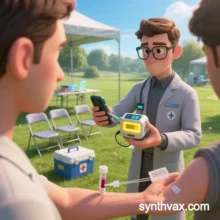
Can Gene Editing Eradicate Cancer? A Multidimensional Analysis
Gene editing technologies—particularly CRISPR-Cas9 and its derivatives—show revolutionary potential in cancer treatment. However, whether they can truly “eradicate cancer” requires a comprehensive analysis across three dimensions: technological breakthroughs, clinical applications, and challenges/ethics.
I. Technological Breakthroughs: Revolutionizing Cancer Treatment
1. Precision Targeting of Cancer Driver Genes
- Oncogene Silencing: CRISPR-mediated knockout of key oncogenes (e.g., KRAS, EGFR) inhibits tumor growth. For example, Prime Editing 2.0 precisely corrects TP53 mutations (present in >50% of cancers), restoring tumor-suppressor function.
- Tumor Suppressor Gene Repair: Fixing defects in BRCA1/2 enhances DNA repair, sensitizing ovarian and breast cancers to chemotherapy.
2. Enhancing the Immune System
- CAR-T Cell Engineering: Deleting inhibitory receptors (e.g., PD-1, TCR) and inserting tumor-specific antigens (e.g., NY-ESO-1) enables T cells to persistently target solid tumors. Clinical trials show durable remission in refractory myeloma.
- NK Cell Optimization: Knocking out immune checkpoint genes (e.g., CISH) boosts NK cell activity against lung and pancreatic cancers.
3. Epigenetic Regulation
- Methylation Editing: Tools like dCas9-DNMT3A silence oncogene promoters via methylation, a strategy validated in Huntington’s disease models and adaptable to cancer.
- Histone Modification: CRISPRa upregulates MHC molecule expression, enhancing tumor immunogenicity.
II. Clinical Translation: From Lab to Bedside
1. Advances in Hematologic Cancers
- CAR-T Therapy: CRISPR-edited CD19-CAR-T achieves 80% complete remission in B-cell lymphoma. Knockout of CD52 enables “universal” CAR-T with reduced rejection.
- Sickle Cell and Leukemia: Exa-cel (targeting BCL11A) frees 90% of β-thalassemia patients from transfusions, a model applicable to leukemia stem cells.
2. Progress in Solid Tumors
- Localized Delivery: Lipid nanoparticles (LNPs) carrying CRISPR systems target AFP in hepatocellular carcinoma, shrinking tumors by 70% in animal models.
- Oncolytic Virus Synergy: Engineered adenoviruses deliver p53 to selectively kill cancer cells, demonstrating safety in liver cancer trials.
3. Overcoming Drug Resistance
- Mismatch Repair Restoration: Editing MLH1/MSH2 restores colorectal cancer sensitivity to checkpoint inhibitors.
- Ferroptosis Induction: GPX4 knockout sensitizes resistant breast cancer cells to ferroptosis, tripling radiotherapy efficacy.
III. Challenges and Limitations
1. Technical Barriers
- Off-Target Effects: Even high-fidelity Cas9 variants (e.g., HypaCas9) retain a 0.01% off-target rate, risking proto-oncogene activation.
- Delivery Efficiency: Only 10–30% of solid tumor cells are reached by LNPs or AAVs due to microenvironment barriers (e.g., fibrosis).
2. Biological Complexity
- Tumor Heterogeneity: Subclonal mutations within tumors challenge single-editing strategies.
- Immune Escape: Cancer cells evade edited T cells via MHC downregulation or TGF-β secretion.
3. Ethical and Accessibility Issues
- Germline Risks: Somatic edits may inadvertently affect germline cells, prompting WHO’s global monitoring.
- Cost Barriers: Personalized CAR-T therapies cost ~$2 million, though lyophilization and automation could reduce prices to <$100,000.
IV. Future Directions
1. Technology Integration
- AI-Driven Design: DeepMind’s AlphaFold-Edit predicts protein-DNA interactions, slashing design cycles to 72 hours.
- Spatiotemporal Control: Light-activated CRISPR (paCas9) enables localized editing, minimizing systemic toxicity.
2. Combination Therapies
- Checkpoint Inhibitor Synergy: PD-1-knockout CAR-T combined with anti-CTLA-4 antibodies shows efficacy in melanoma models.
- Epigenetic Enhancers: HDAC inhibitors improve CRISPR access to chromatin.
3. Universal Platforms
- HLA-Edited Stem Cells: Knockout of HLA-II creates “off-the-shelf” therapies for 95% of patients.
- In Vivo Editing: Intravenous mRNA-LNPs directly edit liver metastases, bypassing ex vivo cell culture.
Conclusion: The Spectrum of Possibilities
Gene editing cannot fully eradicate cancer in the short term but will reshape treatment paradigms through incremental advances:
- 2025–2030: “Functional cures” (5-year progression-free survival >80%) for blood cancers (leukemia, lymphoma) and localized solid tumors (liver cancer, melanoma).
- Post-2030: Expanded applications to refractory cancers (e.g., lung, pancreatic) via multi-gene editing, AI optimization, and delivery breakthroughs.
- Ultimate Goal: Cancer eradication may require combining early detection (liquid biopsy for pre-cancer mutations) with preventive editing (e.g., correcting BRCA1).
Currently, gene editing is best positioned as part of a multidimensional attack network alongside surgery, chemotherapy, radiotherapy, and immunotherapy. Its success hinges on interdisciplinary collaboration, ethical consensus, and equitable global access.
Data sourced from public references. Contact: chuanchuan810@gmail.com.





